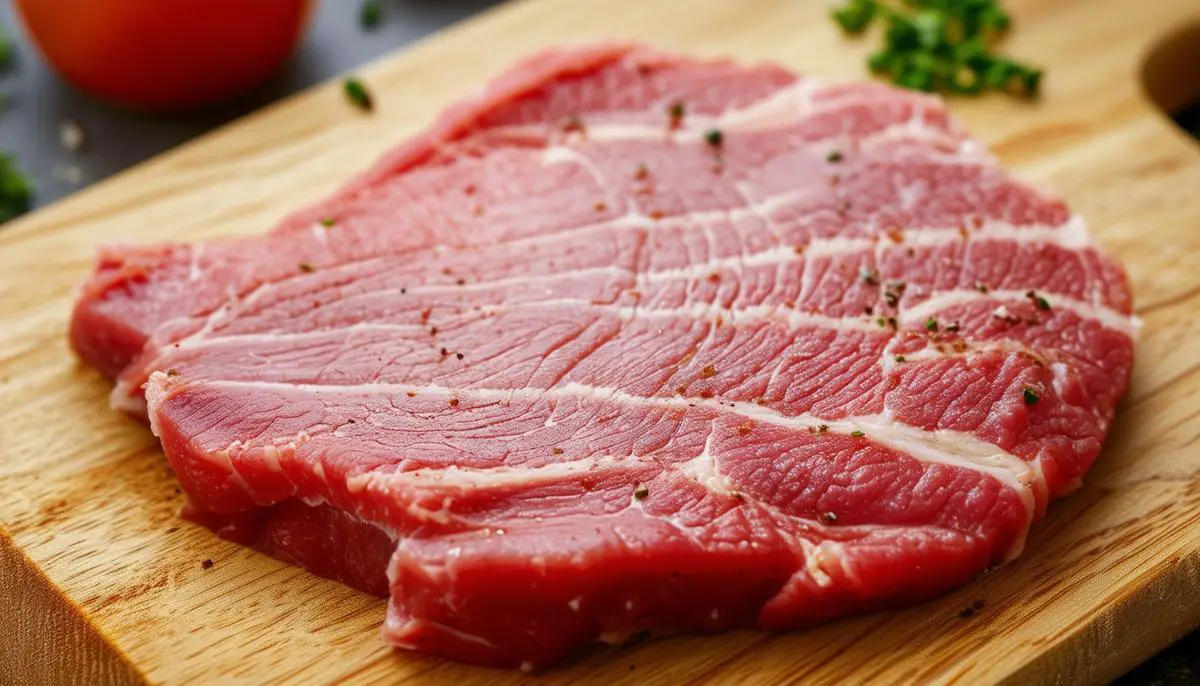
What Are Pork Cutlets?
Pork cutlets—thin, boneless, and tender cuts of pork—are a versatile choice in any culinary repertoire. Derived typically from the pork loin, these cutlets are often pounded thin using a meat mallet, a process that not only tenderizes the meat but also shortens cooking time, allowing for an efficient and flavorful meal. You might find them pre-cut and ready-to-cook in your local grocery store, adding a layer of convenience to this already expedient protein option.
The beauty of pork cutlets lies in their ability to transform into an array of dishes that cater to a variety of tastes and textures. Their thinness ensures they cook swiftly, making them a go-to for weeknight dinners when time is of the essence but flavor must not be compromised. The pounding process breaks down muscle fibers, rendering the meat exceptionally tender and receptive to various marinades and seasonings.
Cutlets stand out for their adaptability. Whether they are breaded and fried for a crispy exterior or lightly sautéed with a medley of fresh herbs, the possibilities seem endless. Their leanness also means they present a healthier protein option, particularly when compared to cuts with higher fat content. The minimal cooking time reduces the risk of overcooking, preserving their naturally tender texture, which can easily become dry if handled poorly in the kitchen.
In a busy modern lifestyle, where culinary efficiency is often paramount, pork cutlets elegantly bridge the gap between convenience and gourmet quality. They offer a canvas that eagerly absorbs and showcases the flavors of accompanying ingredients, making them a standout choice for both novice and seasoned cooks alike.
How to Choose and Prepare Pork Cutlets
When choosing pork cutlets, quality starts with the cut of meat. Look for those derived from the pork loin, as this area provides the most tender and flavorful cuts. If pre-packaged cutlets are unavailable, boneless pork loin chops serve as an excellent alternative. Always select fresh, high-quality pork, ensuring the meat is slightly pink with a minimal amount of fat marbling.
To prepare pork cutlets:
- Cut the boneless pork loin chops into thin slices if they aren't already pre-cut. Aim for slices approximately ¼ inch in thickness.
- Place each piece on a cutting board. Cover them with plastic wrap to prevent splatter and keep the meat clean.
- Using the flat side of a meat mallet, pound each cutlet gently but firmly. The goal is to achieve an even thickness throughout. This not only ensures uniform cooking but also enhances the tenderness of the meat. Be attentive not to tear the meat fibers.
- Season the cutlets on both sides with a pinch of flaky sea salt and freshly ground black pepper. This basic seasoning allows the natural flavors of the pork to shine while also creating a foundation for further seasoning or marinades.
With the cutlets expertly prepared, you're now ready to transform them into a gourmet dish that embodies the essence of both simplicity and sophistication.

Variations of Pork Cutlet Recipes
Pork Schnitzel
A classic Austrian dish, pork schnitzel features thinly pounded pork cutlets that are breaded and fried until golden and crisp. The hallmark of a schnitzel lies in its triple coating process—first dredged in flour, then dipped in beaten eggs, and finally coated with breadcrumbs. The final frying is done in a shallow pool of neutral oil until each side reaches a perfect golden hue. Traditionally served with a slice of lemon, schnitzel offers a burst of fresh acidity that complements the crispy, savory nature of the pork.
Breaded Pork Cutlets
Breaded pork cutlets are a comforting staple in many households, offering a crunchy exterior with a juicy interior. The preparation involves dipping the seasoned cutlets in a mixture of crushed saltine crackers or breadcrumbs before frying them in hot oil. The key to achieving perfect breaded cutlets is ensuring the oil is at the correct temperature—around 325°F to 350°F. This high heat locks in moisture while creating a crisp, golden-brown crust. Variations can include adding grated Parmesan cheese or dried herbs to the breadcrumb mixture for additional flavor.
Venetian-Style Pork Cutlets
Inspired by Venetian cuisine, these cutlets are characterized by their unique finishing touch—a bright splash of vinegar. After the pork cutlets are breaded and pan-fried to a crisp, they are returned to the skillet and doused with white wine vinegar. The vinegar evaporates quickly, leaving behind a tangy, mouthwatering flavor that cuts through the richness of the fried pork. This method transforms simple cutlets into a dish brimming with complexity and depth.
Air-Fried Cutlets
For a healthier alternative without sacrificing texture, air-fried pork cutlets are an excellent option. These cutlets are coated similarly to traditional breaded cutlets—using flour, egg, and panko breadcrumbs—but are cooked using an air fryer. This method requires significantly less oil, relying on hot air circulation to achieve a crispy exterior while keeping the pork moist and tender. Ideal for those mindful of their fat intake, air-fried cutlets offer a guilt-free yet satisfying meal.
Each variation of pork cutlets brings its own distinctive flavor profile and culinary technique, demonstrating the remarkable versatility of this beloved dish. Whether you prefer the tang of a Venetian-style cutlet or the ease of an air-fried version, these recipes are sure to delight and impress at any gathering.
Tips for Perfect Pork Cutlets
Ensure the pork is dry before breading:
Pat the cutlets dry with a paper towel. Moisture on the surface of the pork can hinder the breading from adhering properly, leading to a less-than-crispy exterior. Dry pork cutlets ensure that the flour, egg, and breadcrumbs cling evenly, forming a uniform crust.
Use the right type of oil for frying:
Select a neutral oil with a high smoke point, such as vegetable oil or canola oil. These oils can withstand the high temperatures needed for frying without imparting any unwanted flavors to the meat. Avoid using oils with low smoke points, like olive oil, as they can burn easily and affect the taste.
Maintain the appropriate oil temperature:
Preheat the oil to 325°F to 350°F before adding the cutlets. You can test the oil by dropping a small breadcrumb into it; if it sizzles and floats, the oil is ready. Too hot, and the cutlets will burn on the outside while remaining undercooked inside; too cold, and they will absorb too much oil, becoming greasy.
Ensure crispiness and maintain tenderness:
Double-coating the cutlets can enhance their crispiness. After the initial coating of flour, egg, and breadcrumbs, repeat the egg and breadcrumb steps. This additional layer ensures a thicker, crunchier crust. Avoid overcrowding the pan, as this can lower the oil temperature and result in soggy cutlets. Fry the cutlets in batches, allowing enough space for each piece to cook evenly.
Use a meat thermometer:
To ensure the pork cutlets are cooked to perfection, use a meat thermometer to check the internal temperature. Pork should reach an internal temperature of 145°F.[1] Insert the thermometer into the thickest part of the cutlet to get an accurate reading. Rest the cutlets for a few minutes after cooking to allow juices to redistribute, ensuring a moist and flavorful bite in every mouthful.
By following these tips, you'll achieve pork cutlets that are impeccably crispy on the outside and delectably tender on the inside, offering a dining experience that rivals any restaurant fare.

Recipe: Classic Breaded Pork Cutlets
Ingredients:
- 4 boneless pork cutlets, approximately 1½ pounds
- Salt and pepper
- 2 large eggs
- 1 sleeve saltine crackers, crushed
- Vegetable oil for frying
Instructions:
- Begin by patting the pork cutlets dry with a paper towel. Lightly sprinkle both sides with salt and pepper.
- In a shallow bowl, whisk the eggs together. Add the crushed saltine crackers to another shallow bowl.
- Dip each pork cutlet into the beaten eggs, ensuring both sides are coated.
- Press the egg-coated cutlet into the crushed crackers, covering both sides thoroughly.
- Heat enough vegetable oil in a skillet to cover the bottom, approximately 1/8 inch deep. Preheat the oil to 325°F.
- Place the cutlets in the skillet, frying until golden brown and crispy, about 5-6 minutes per side. Ensure the internal temperature reaches 145°F using a meat thermometer.
- Transfer the cutlets to a paper towel-lined plate to drain any excess oil. Serve immediately.
Nutritional information per serving:
kcal: 320
carbohydrates: 8g
protein: 32g
fat: 18g
saturated fat: 3g
sodium: 280mg
Serving Suggestions
For serving these delectable breaded pork cutlets, the options are wonderfully varied, offering opportunities to customize the dish to your preferences. Consider:
- Garnishing the cutlets with fresh lemon wedges for a zesty finish that brightens the savory and crispy attributes of the pork.
- Pairing the cutlets with a robust marinara sauce or a rich cream sauce to add a comforting, velvety component to the meal.
- Transforming the cutlets into sandwiches by layering them between crusty bread with a spread of tangy mayo, fresh lettuce, and ripe tomatoes for a satisfying, handheld delight.
Complementary sides can elevate the meal further:
- Mashed potatoes create a classic and comforting pairing with the crunchy pork, especially when smothered in gravy.
- Sautéed peppers provide a vibrant and slightly sweet contrast that complements the savory notes of the pork.
- A simple arugula salad dressed with a light vinaigrette adds a refreshing, peppery note that balances the richness of the cutlets.
These versatile serving options ensure that the breaded pork cutlets can seamlessly fit into various meal settings, whether it's a casual family dinner or a more refined gathering.

- U.S. Department of Health & Human Services. Safe Minimum Cooking Temperatures Chart. Foodsafety.gov. https://www.foodsafety.gov/food-safety-charts/safe-minimum-cooking-temperature. Published 2019.



